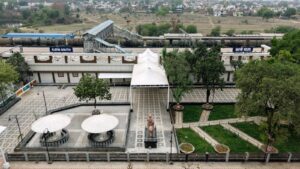Prime Minister Narendra Modi inaugurated 103 redeveloped Amrit Bharat railway stations across India, marking a significant step in rail modernization. With over Rs. 1,100 crore invested, these culturally-inspired, passenger-centric stations show India’s architectural diversity. The initiative also consists of major rail electrification projects and highlighted ongoing rail infrastructure transformations worldwide.
Introduction:
As a noteworthy advancement toward infrastructure modernization, Prime Minister Shri Narendra Modi inaugurated 103 redeveloped railway stations under the Amrit Bharat Station Scheme. These stations span 86 districts across 18 States and Union Territories, built with a combined investment of over Rs. 1,100 crore. The main event was inauguration of the Deshnok Amrit Station of Rajasthan and flagging off the new train between Bikaner-Mumbai (Bandra Terminus) by PM Modi.
The stations, redesigned with a collaboration of modern facilities and regional architecture, are part of Indian Railways’ broader goal to upgrade over 1,300 railway stations across the nation. The scheme not only focusses on physical transformation but also aims at sustainability, inclusivity, and improved passenger experience.

Architecture Meets Culture at New Amrit Stations:
- Deshnoke Station (Rajasthan): Shows temple-inspired design with arches and columns, welcoming pilgrims visiting the famed Karni Mata Temple.
- Begumpet Station (Telangana): Infused with the Kakatiya Empire architectural elements, mixing heritage with contemporary facilities.
- Thawe Station (Bihar): Decorated with Madhubani paintings and murals celebrating Maa Thawewali, one of the 52 Shakti Peethas.
- Dakor Station (Gujarat): Inspired by the spiritual essence of Ranchhodrai Ji Maharaj, merging spiritual devotion with rail mobility.
These stations also feature Divyangjan-friendly facilities, digital signage, food courts, better waiting areas, and green practices like solar panels and rainwater harvesting, improving both accessibility and sustainability.
Electrification Boost and Green Rail Operations:
In addition to station redevelopment, the Prime Minister emphasized the electrification of major rail lines, boosting the Indian Railways’ mission of achieving 100% electrification. Key projects included-
Foundation Stone Laid–
- Churu–Sadulpur Line (58 km)
Electrification Inaugurated–
- Suratgarh–Phalodi (336 km)
- Phulera–Degana (109 km)
- Udaipur–Himmatnagar (210 km)
- Phalodi–Jaisalmer (157 km)
- Samdari–Barmer (129 km)
These initiatives significantly minimise carbon emissions, accelerate energy efficiency, and increase operational speed and capacity on key regional routes.
Rajasthan on the Railway Fast Track:
Rajasthan emerged as a focal point of the event. PM Modi announced that the central government will invest nearly Rs. 10,000 crore in the state’s rail infrastructure this year, representing a 15-fold increase from pre-2014 levels. As part of these initiatives-
- A new train service between Bikaner and Mumbai was flagged off, accelerating north-western India’s connectivity to key economic hubs.
- The Delhi-Mumbai Expressway, nearing completion in Rajasthan, will further catalyze industrial and logistical growth, benefiting both urban and rural regions.
This comprehensive connectivity push is expected to create local employment, spur regional development, and minimise migration by ensuring opportunities within smaller towns.
A Decade of Modernization and Expansion:
Reflecting on the last 11 years of railway transformation, the Prime Minister cited the rollout of modern trains like Vande Bharat, Amrit Bharat, and Namo Bharat as record of India’s progress in transportation technology. Highlights include:
- 70 Vande Bharat train routes are now operational, providing faster, more comfortable travel across remote regions.
- 34,000 km of new tracks laid, expanding the national railway network substantially.
- Hundreds of Road Overbridges (ROBs) and Underbridges constructed to eradicate bottlenecks.
- All unmanned level crossings on broad gauge lines have been removed to improve rail safety.
- Rapid development of Dedicated Freight Corridors (DFCs) to streamline goods transport.
- Construction of India’s first Bullet Train project between Mumbai and Ahmedabad advancing rapidly.
These cumulative efforts are changing Indian Railways into a global benchmark for safe, fast, and sustainable transport.
Conclusion:
The inauguration of 103 redeveloped Amrit Bharat Stations stands as a testament to India’s renewed focus on infrastructure with identity. These stations, blending culture with convenience, and the broader initiatives in electrification, expressway expansion, and smart trains, signal India’s significant leap toward a modern, inclusive, and future-ready railway system. As the nation continues to invest in rail development, passengers can look forward to a safer, faster, and more enriching travel experience rooted in India’s diverse cultural fabric.
Source: PIB – Press Release | Image Credit (representational): MoR
Join us to showcase Innovation in Rail & Metro sector of India- Book your Delegate Pass: https://railanalysis.in/info/delegate.html
![]() Timely insights, straight to your WhatsApp—stay updated with ease!
Timely insights, straight to your WhatsApp—stay updated with ease!
![]() Stay connected to the rail industry—timely news, straight to Telegram!
Stay connected to the rail industry—timely news, straight to Telegram!


